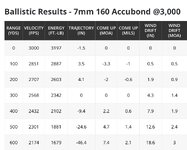For over 40 years I’ve zeroed at 300. For everything from 243 to 270, 7 mag, creedmoor, ‘06, 300 mag, etc., it gets your point of impact dead center when holding a hand width low for 100 & 200 yards, a hand width high for 350 yards and on the back at 400 for mule deer, and past that gets dialed. Check out how well the 7 mag 300 yard zero matches this system.
For years folks acted like this was crazy talk when all everyone could think of was dialing, but now even the Hornady podcast boys let it slip they do something very similar. Millions of animals have been taken with holdovers (and unders), at the very least folks should understand how to do it well. Grab 4 cardboard boxes about 20” tall (mule deer chest depth) and spread them out every hundred yards and many hunters are surprised how easy it is to hit every one well.
Those that haven’t lost an animal to time wasting dialing short distance as it slowly walks over the ridge or behind a tree, eventually will.
I never liked maximum point blank range where the bullet impact is much further off above and below. Don’t confuse good holdovers with max point blank.
In the end whatever rules of thumb work well for you should be practiced enough to be second nature.
 View attachment 901741
View attachment 901741

